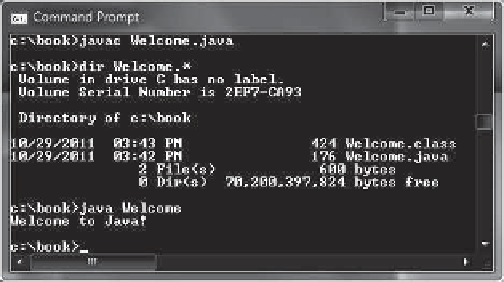Java Reference
In-Depth Information
B
compiled
by
executed
by
generates
Welcome.java
(Java source-
code file)
Welcome.class
(Java bytecode
executable file)
Java
Compiler
Any
Computer
JVM
Library Code
(a)
(b)
F
IGURE
1.8
(a) Java source code is translated into bytecode. (b) Java bytecode can be executed on any computer with a
Java Virtual Machine.
Figure 1.9 shows the
javac
command for compiling
Welcome.java
. The compiler gener-
ates the
Welcome.class
file, and this file is executed using the
java
command.
javac
command
java
command
Note
For simplicity and consistency, all source-code and class files used in this topic are
placed under
c:\book
unless specified otherwise.
c:\book
Compile
Show files
VideoNote
Compile and run a Java
program
Run
F
IGURE
1.9
The output of Listing 1.1 displays the message “Welcome to Java!”
Caution
Do not use the extension
.class
in the command line when executing the program.
Use
java ClassName
to run the program. If you use
java ClassName.class
in the command line, the system will attempt to fetch
ClassName.class.class
.
java ClassName
Tip
If you execute a class file that does not exist, a
NoClassDefFoundError
will occur.
If you execute a class file that does not have a
main
method or you mistype the
main
method (e.g., by typing
Main
instead of
main
), a
NoSuchMethodError
will occur.
NoClassDefFoundError
NoSuchMethodError
Note
When executing a Java program, the JVM first loads the bytecode of the class to mem-
ory using a program called the
class loader.
If your program uses other classes, the class
loader dynamically loads them just before they are needed. After a class is loaded, the
JVM uses a program called the
bytecode verifier
to check the validity of the bytecode and
class loader
bytecode verifier










































Search WWH ::

Custom Search